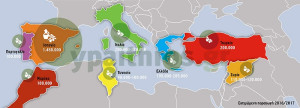Harvest is just about to begin in the Mediterranean region. Spain will again approach 1,500,000 tons of its industrially produced varietals, with Italy, Greece and Turkey at around 200,000 tons each. Up and coming Portugal, Tunisia, Morocco and war-torn Syria will reach around 100,000 tons each. Minor producers limited to domestic consumption include, France, Israel, Egypt, Libya and Algeria. The rest of the world accounts to no more than 10% of the global olive oil production of a little over 3 million tons for 2016-17.
The question remains as to how much of what will qualify as extra virgin (less that 40%) will remain unadulterated, and how much of the prize-winning EVOOs will reach the average consumer. Greece tops the world in extra virgin production at 85% of total (USDA report). The highly revered EVOOs from the Peloponnese and Crete are in their low output year, but still account for 43% and 32% respectively of the national output, which will be mostly consumed domestically.
Spanish interests now also own the best known Italian brands sold in the USA. Italy hasn’t yet recovered from the weather conditions and the fruit fly that reduced last season’s harvest to a fraction of its annual 500,000 tons. This year’s forecast of 200,000 is better but still suffers from the deadly effects of xylella fastidiosa which, since 2013, has forced growers to raze whole orchards in order to restrain its spreading (https://www.scientificamerican.com/article/italy-s-olive-trees-didn-t-have-to-die) With domestic Italian consumption amounting to 500,000 tons annually, that is 2.5 times over the country’s domestic production, one wonders whose oil do the Italian export brands bottle? (https://www.truthinoliveoil.com/2016/01/strange-case-italian-olive-oil ).
Source:www.olivenews.gr





